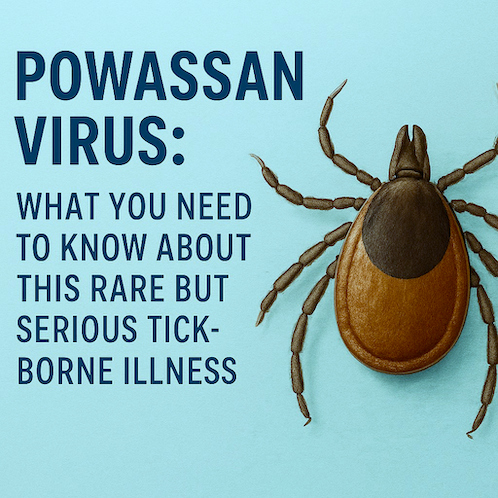Stay updated on what is trending in health. Discover tips and resources for a healthier, balanced life.
Powassan Virus: Symptoms, Risks, and Prevention of This Rare Tick-Borne Illness
Learn about Powassan virus, a rare but serious tick-borne illness that can cause brain infections like encephalitis and meningitis. Discover symptoms, how it spreads, and prevention tips to protect yourself and your family.
DISEASES AND CONDITIONS
Dr. S. Ali
9/27/20254 min read


When most people think of ticks, they worry about Lyme disease—and rightly so. But there’s another, lesser-known virus you should be aware of: Powassan virus. It's rare, yes, but it's also potentially serious, and cases have been on the rise in recent years.
So what exactly is Powassan virus? How do you get it? And most importantly—how can you protect yourself and your family?
Let’s break it down in simple terms.
What Is Powassan Virus?
Powassan virus (POW) is a tick-borne virus that can cause inflammation of the brain (encephalitis) or the membranes around the brain and spinal cord (meningitis). Unlike Lyme disease, which is caused by bacteria, Powassan is caused by a virus—and that means there’s no antibiotic to treat it.
It’s named after the town of Powassan, Ontario, where the first known case was reported back in 1958.
How Do You Get It?
Just like Lyme disease, Powassan virus is spread through the bite of an infected tick—most commonly the blacklegged tick, also known as the deer tick (the same tick that carries Lyme). However, there’s a key difference:
Powassan virus can be transmitted in as little as 15 minutes after a tick bite—unlike Lyme disease, which usually takes 24–48 hours. That’s why it’s so important to do tick checks often and remove them as soon as possible.
Where Is It Found?
Powassan virus isn’t found everywhere, but cases have been reported in the northeastern and Great Lakes regions of the United States, as well as parts of Canada. States like New York, Maine, Minnesota, and Wisconsin have seen the most cases.
Still, with climate change and tick populations expanding, the risk areas are growing.
Does the Tick That Spreads Powassan Virus Live Near People?
Yes—unfortunately, it can.
The blacklegged tick (deer tick), which spreads Powassan virus, doesn’t fly or jump like mosquitoes. But it does live in areas where people often spend time—especially in grassy, bushy, or wooded places. That includes:
Forests and wooded trails
Leaf piles and tall grass
Gardens and backyards near woods
Edges of lawns and parks with dense vegetation
While ticks don’t actively seek people out like mosquitoes do, they wait quietly on the tips of grass or leaves (a behavior called “questing”), and latch onto you when you brush past.
They’re most active in spring through fall, but in milder climates, they can be found year-round. And as people build homes near forests or enjoy more time outdoors, the chances of crossing paths with these ticks increase.
What Are the Symptoms?
Here’s the tricky part: many people who get infected never develop symptoms at all. But for those who do, symptoms usually show up about 1 to 4 weeks after a tick bite.
Mild symptoms might include:
Fever
A sudden spike in body temperature is often the first sign that your immune system is fighting off the virus.Headache
You might experience a dull, persistent headache that doesn’t improve with rest or over-the-counter pain relievers.Fatigue
Feeling unusually tired or worn out, even after a good night’s sleep, is a common early symptom.Nausea
Some people report feeling queasy or even vomiting in the early stages of infection.
In more serious cases, the virus can attack the brain or nervous system, leading to:
Confusion
You may feel mentally foggy, forgetful, or have trouble concentrating on simple tasks.Seizures
In rare but severe cases, Powassan virus can trigger seizures due to inflammation in the brain.Trouble speaking or walking
Coordination and speech may become difficult, signaling potential damage to the nervous system.Memory loss
Short-term memory can be affected, and some people may struggle to recall recent events or conversations.Muscle weakness
You might feel weakness in your limbs or have difficulty lifting objects or walking steadily.Meningitis (inflammation of the membranes around the brain and spinal cord)
Often marked by a stiff neck, sensitivity to light, and severe headache, this condition requires immediate medical attention.Encephalitis (inflammation of the brain)
This serious complication can cause swelling in the brain, leading to severe neurological symptoms and hospitalization.
Severe Powassan infections can lead to permanent neurological damage—and in some cases, can be fatal. About 1 in 10 people with severe illness do not survive.
Is There a Test or Treatment?
There’s no specific treatment for Powassan virus. If you become seriously ill, doctors will focus on supportive care—like IV fluids, oxygen, or medications to reduce brain swelling. Recovery can be slow, especially if the nervous system is affected.
Testing is usually done through blood or spinal fluid and sent to specialized labs (like the CDC) for confirmation.
How Can You Protect Yourself?
Tick prevention is your best defense. Here’s what you can do:
Use tick repellents: Products with DEET, picaridin, or permethrin can help keep ticks away.
Dress smart: Wear long sleeves, long pants tucked into socks, and light-colored clothing so you can spot ticks easily.
Avoid high-risk areas: Ticks love wooded, brushy, and grassy areas. Stay in the center of trails when hiking.
Do daily tick checks: Especially after spending time outdoors. Check behind your knees, around your ears, your scalp, and under your arms.
Don’t forget your pets: Dogs can bring ticks into your home. Use vet-approved tick preventatives.
Shower after outdoor activities: It helps wash off ticks before they attach and gives you a chance to check for them.
Bottom Line
Powassan virus is rare—but real. And while the chances of getting it are still low, the consequences can be severe. If you live in or travel to areas where deer ticks are common, take tick prevention seriously.
Stay informed. Stay cautious. And don’t let the fear of ticks keep you from enjoying nature—just be smart about it.
Quick Recap
Powassan virus is a rare but serious tick-borne illness.
It can cause brain inflammation and long-term neurological problems.
It spreads faster than Lyme—sometimes within 15 minutes of a tick bite.
There’s no cure, so prevention is key.
Related Articles:
1. What is Meningitis? What Causes It, and How to Protect Yourself
2. Lyme Disease: Symptoms, Prevention, and Treatment
Sources:
CDC – Powassan Virus Overview
https://www.cdc.gov/powassan/about/index.htmlCDC – Powassan Virus Data and Maps
https://www.cdc.gov/powassan/data-maps/index.htmlCDC – Educational Materials and Resources
https://www.cdc.gov/powassan/php/resources/index.htmlMassachusetts Department of Public Health – Powassan Virus
https://www.mass.gov/service-details/powassan-virusSELF Magazine – What to Know About Powassan Virus
https://www.self.com/story/powassan-virus-maine-deathNew York State Department of Health – Powassan Virus Fact Sheet
https://www.health.ny.gov/diseases/communicable/powassan/fact_sheet.htm
Pulse Your Health
Empowering you to achieve your health goals.
Contact
© 2025. All rights reserved.
Disclaimer: The content on this website is for informational purposes only and is not medical advice. Always seek the advice of your physician or other suitably qualified healthcare professional for diagnosis, treatment and your health related needs.
